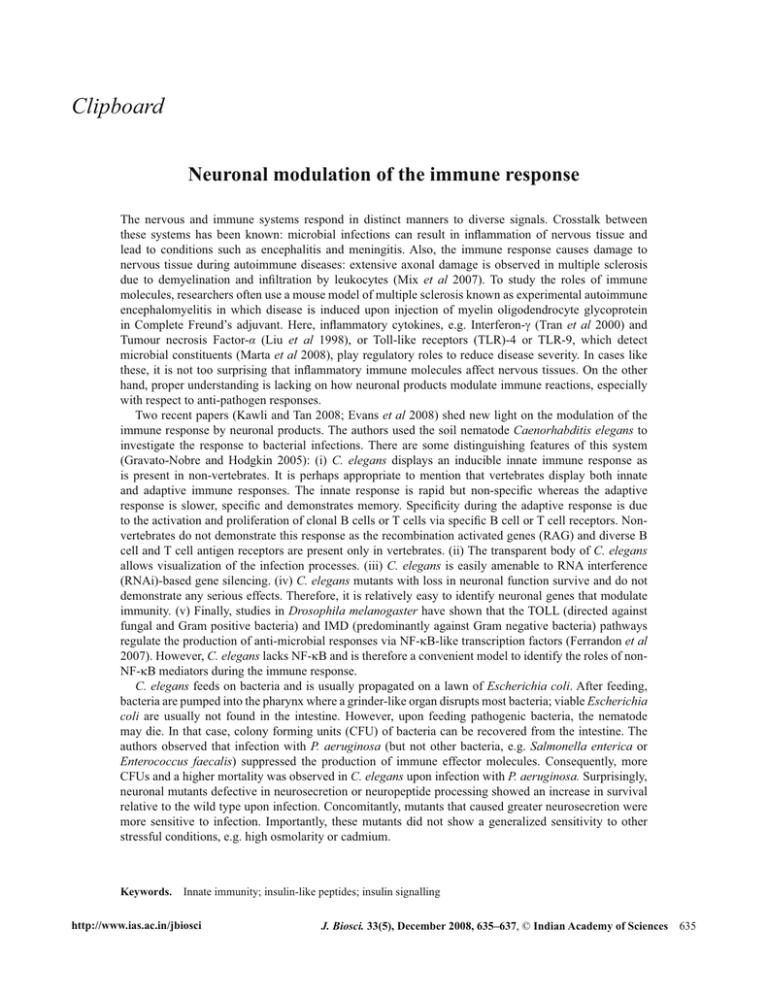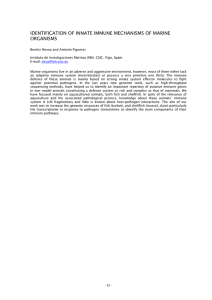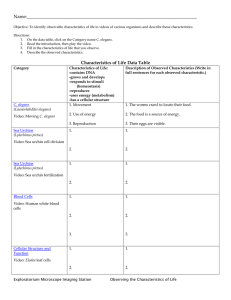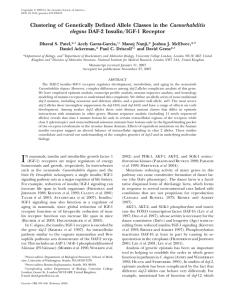Clipboard Neuronal modulation of the immune response
advertisement

Clipboard Neuronal modulation of the immune response The nervous and immune systems respond in distinct manners to diverse signals. Crosstalk between these systems has been known: microbial infections can result in inflammation of nervous tissue and lead to conditions such as encephalitis and meningitis. Also, the immune response causes damage to nervous tissue during autoimmune diseases: extensive axonal damage is observed in multiple sclerosis due to demyelination and infiltration by leukocytes (Mix et al 2007). To study the roles of immune molecules, researchers often use a mouse model of multiple sclerosis known as experimental autoimmune encephalomyelitis in which disease is induced upon injection of myelin oligodendrocyte glycoprotein in Complete Freund’s adjuvant. Here, inflammatory cytokines, e.g. Interferon-γ (Tran et al 2000) and Tumour necrosis Factor-α (Liu et al 1998), or Toll-like receptors (TLR)-4 or TLR-9, which detect microbial constituents (Marta et al 2008), play regulatory roles to reduce disease severity. In cases like these, it is not too surprising that inflammatory immune molecules affect nervous tissues. On the other hand, proper understanding is lacking on how neuronal products modulate immune reactions, especially with respect to anti-pathogen responses. Two recent papers (Kawli and Tan 2008; Evans et al 2008) shed new light on the modulation of the immune response by neuronal products. The authors used the soil nematode Caenorhabditis elegans to investigate the response to bacterial infections. There are some distinguishing features of this system (Gravato-Nobre and Hodgkin 2005): (i) C. elegans displays an inducible innate immune response as is present in non-vertebrates. It is perhaps appropriate to mention that vertebrates display both innate and adaptive immune responses. The innate response is rapid but non-specific whereas the adaptive response is slower, specific and demonstrates memory. Specificity during the adaptive response is due to the activation and proliferation of clonal B cells or T cells via specific B cell or T cell receptors. Nonvertebrates do not demonstrate this response as the recombination activated genes (RAG) and diverse B cell and T cell antigen receptors are present only in vertebrates. (ii) The transparent body of C. elegans allows visualization of the infection processes. (iii) C. elegans is easily amenable to RNA interference (RNAi)-based gene silencing. (iv) C. elegans mutants with loss in neuronal function survive and do not demonstrate any serious effects. Therefore, it is relatively easy to identify neuronal genes that modulate immunity. (v) Finally, studies in Drosophila melanogaster have shown that the TOLL (directed against fungal and Gram positive bacteria) and IMD (predominantly against Gram negative bacteria) pathways regulate the production of anti-microbial responses via NF-κB-like transcription factors (Ferrandon et al 2007). However, C. elegans lacks NF-κB and is therefore a convenient model to identify the roles of nonNF-κB mediators during the immune response. C. elegans feeds on bacteria and is usually propagated on a lawn of Escherichia coli. After feeding, bacteria are pumped into the pharynx where a grinder-like organ disrupts most bacteria; viable Escherichia coli are usually not found in the intestine. However, upon feeding pathogenic bacteria, the nematode may die. In that case, colony forming units (CFU) of bacteria can be recovered from the intestine. The authors observed that infection with P. aeruginosa (but not other bacteria, e.g. Salmonella enterica or Enterococcus faecalis) suppressed the production of immune effector molecules. Consequently, more CFUs and a higher mortality was observed in C. elegans upon infection with P. aeruginosa. Surprisingly, neuronal mutants defective in neurosecretion or neuropeptide processing showed an increase in survival relative to the wild type upon infection. Concomitantly, mutants that caused greater neurosecretion were more sensitive to infection. Importantly, these mutants did not show a generalized sensitivity to other stressful conditions, e.g. high osmolarity or cadmium. Keywords. Innate immunity; insulin-like peptides; insulin signalling http://www.ias.ac.in/jbiosci J. Biosci. 33(5), December 2008, 635–637, © Indian Academy of Sciences 635 Clipboard 636 Further studies demonstrated that an insulin-like peptide (INS)-7 was induced and secreted by neuronal cells upon P. aeruginosa infection. INS-7 binds to DAF-2, a transmembrane tyrosine kinase insulin receptor, and enhanced signalling by this receptor leads to cytosolic localization of intestinal DAF-16, a member of the forkhead transcription factor family. This relocalization (from the nucleus to the cytosol) leads to reduced transcriptional activation of several immune response genes: lys-7 (encoding a lysozymelike protein), spp-1 (encoding a saponin-like protein), thn-2 (encoding a member of the thaumatin family of plant anti-fungal proteins) etc. The tissue-specificity of gene expression i.e. neuronal INS-7 and intestinal DAF-16, is important, because the intestine is the target of P. aeruginosa infection and the site of expression of host defense genes. Clearly, a correlation exists between the secretion of INS-7, the DAF2 signalling pathway and the cytosolic location of DAF-16, which leads to a lowered immune response and greater susceptibility to infection by P. aeruginosa (figure 1). These studies, demonstrating a sensitive mechanism to detect and respond to pathogenic bacteria, are important and raise several questions: What are the roles of other neurosecretory peptides and their receptors in immune modulation? Perhaps, the identification of INS-7 is the tip of an iceberg and there are other players and pathways that need to be studied. Also, DAF-2 and DAF-16 are important in other Infection by virulent P. aeruginosa Up-regulation of some neuronal insulin-like peptides (INS) in C. elegans followed by their exocytosis from dense core vesicles INS 7 INS-7 binds to DAF-2, a transmembrane tyrosine kinase insulin receptor D A F 2 D A F 2 DAF-16 Signaling leads to cytosolic localization of DAF-16, a forkhead transcription factor, in intestinal cells expression of lys-7, thn-2 and spp-1 Low expression of intestinal immune-related genes Increase in intestinal load of P. aeruginosa Lower survival of C. elegans Figure 1. Flow chart of events occurring upon infection of C. elegans with virulent P. aeruginosa. The outcome is the activation of an insulin-like signalling pathway followed by a reduction in the immune response. J. Biosci. 33(5), December 2008 Clipboard 637 cellular functions. C. elegans lacking daf-2 are long-lived and resistant to oxidative stress whereas those lacking daf-16 are short lived and sensitive to oxidative stress (Ogg et al 1997; Garsin et al 2007). The transcriptional targets of DAF-16 have been studied (Oh et al 2006) and it may be useful to identify those directly involved in immune defense and functionally evaluate their roles during infection. What are the implications of these studies for higher organisms? With respect to innate immune responses, it is known that Toll-like receptors enhance inflammatory responses and modulate insulin signalling during obesity (Shi et al 2006; Kim et al 2007). However, the role of insulin signalling in directly modulating immune responses is not well known. Interestingly, there are several insulin-like peptides in mice and humans which bind to G protein coupled receptors and play diverse roles, e.g. in collagen turnover, fertility, pregnancy, etc. (van der Westhuizen et al 2008). A closer look is now required to evaluate their effects on immune cell gene expression and function in vertebrates. References Evans E A, Kawli T and Tan M W 2008 Pseudomonas aeruginosa suppresses host immunity by activating the DAF-2 insulin-like signalling pathway in Caenorhabditis elegans; PLoS Pathog. doi: 10.1371/journal.Ppat.1000175 Ferrandon D, Imler J L, Hetru C and Hoffmann J A 2007 The Drosophila systemic immune response: sensing and signalling during bacterial and fungal infections; Nat. Rev. Immunol. 7 862–874 Garsin D A, Villanueva J M, Begun J, Kim D H, Sifri C D, Calderwood S B, Ruvkun G and Ausubel F M 2003 Long-lived C. elegans daf-2 mutants are resistant to bacterial pathogens; Science 300 1921 Gravato-Nobre M J and Hodgkin J 2005 Caenorhabditis elegans as a model for innate immunity to pathogens; Cell Microbiol. 7 741–751 Kawli T and Tan M W 2008 Neuroendocrine signals modulate the innate immunity of Caenorhabditis elegans through insulin signalling; Nat. Immunol. doi: 10.1038/ni.1672 Kim F, Pham M, Luttrell I, Bannerman D D, Tupper J, Thaler J, Hawn T R, Raines E W and Schwartz M W 2007 Toll-like receptor-4 mediates vascular inflammation and insulin resistance in diet-induced obesity; Circ. Res. 100 1589–1596 Liu J, Marino M W, Wong G, Grail D, Dunn A, Bettadapura J, Slavin A J, Old L and Bernard C C 1998 TNF is a potent anti-inflammatory cytokine in autoimmune-mediated demyelination; Nat. Med. 4 78–83 Mix E, Goertsches R and Zettl U K 2007 Immunology and neurology; J. Neurol. (Suppl. 2) 254 II2–II7 Marta M, Andersson A, Isaksson M, Kämpe O and Lobell A 2008 Unexpected regulatory roles of TLR4 and TLR9 in experimental autoimmune encephalomyelitis; Eur. J. Immunol. 38 565–575 Ogg S, Paradis S, Gottlieb S, Patterson G I, Lee L, Tissenbaum H A and Ruvkun G 1997 The Forkhead transcription factor DAF-16 transduces insulin-like metabolic and longevity signals in C. elegans; Nature (London) 389 994–999 Oh S W, Mukhopadhyay A, Dixit B L, Raha T, Green M R and Tissenbaum H A 2006 Identification of direct DAF16 targets controlling longevity, metabolism and diapause by chromatin immunoprecipitation; Nat. Genet. 38 251–257 Shi H, Kokoeva M V, Inouye K, Tzameli I, Yin H and Flier J S 2006 TLR4 links innate immunity and fatty acidinduced insulin resistance; J. Clin. Invest. 116 3015–3025 Tran E H, Prince E N and Owens T 2000 IFN-gamma shapes immune invasion of the central nervous system via regulation of chemokines; J. Immunol. 164 2759–2768 van der Westhuizen E T, Halls M L, Samuel C S, Bathgate R A, Unemori E N, Sutton S W and Summers R J 2008 Relaxin family peptide receptors – from orphans to therapeutic targets; Drug Discov. Today 13 640–651 DIPANKAR NANDI* and MANOJ BHOSALE Department of Biochemistry, Indian Institute of Science, Bangalore 560 012, India *(Email, nandi@biochem.iisc.ernet.in) ePublication: 13 November 2008 J. Biosci. 33(5), December 2008






